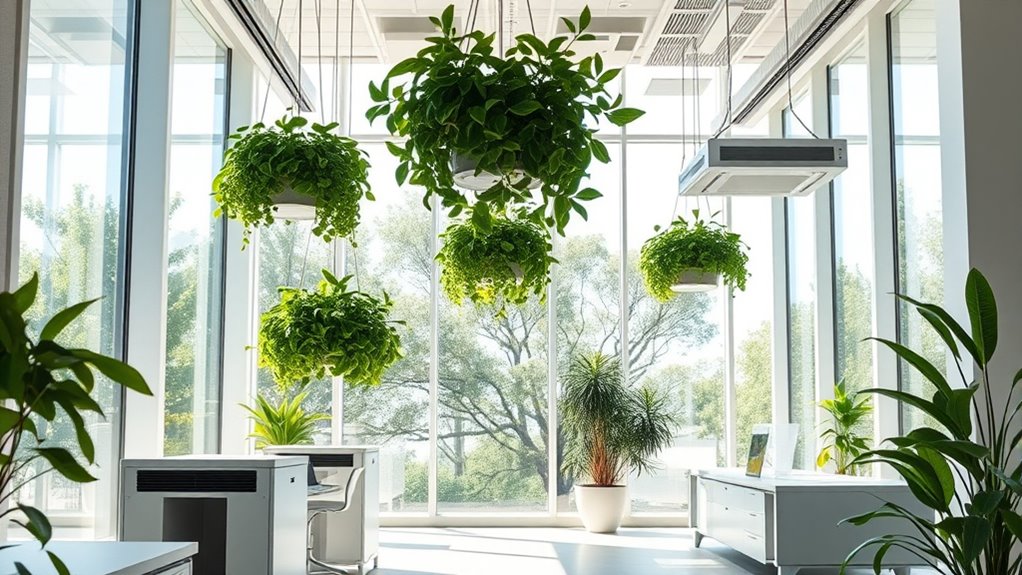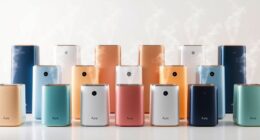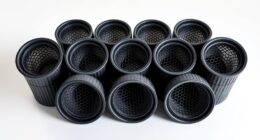To earn Fitwel certification, you need strong indoor air strategies that improve air quality and occupant health. This includes optimizing ventilation standards to ensure fresh air circulation, reducing pollutants through source control, using high-efficiency filters, and maintaining HVAC systems. Incorporating fewer toxic materials and adding indoor plants can also help. These measures lower illness risks and boost comfort. Keep exploring to discover how these strategies come together for healthier indoor environments.
Key Takeaways
- Implementing proper ventilation standards ensures effective air circulation and contaminant removal, improving indoor air quality for occupants.
- Using source control measures like low-emission materials and non-toxic paints reduces indoor pollutant sources.
- Incorporating high-efficiency filters and maintaining HVAC systems optimize pollutant capture and air purity.
- Meeting indoor air quality standards supports occupant health, comfort, and concentration, aligning with Fitwel’s goals.
- Combining ventilation and pollutant reduction strategies creates healthier, safer indoor environments and enhances building sustainability.

Fitwel Certification is a widely recognized standard that highlights how healthy and sustainable a building is. When aiming for this certification, you’re focusing on creating indoor environments that promote occupant well-being through thoughtful design and operational strategies. One of the core aspects of achieving Fitwel’s indoor air quality goals involves adhering to strict ventilation standards. These standards ensure that fresh air circulates effectively throughout the space, reducing the buildup of indoor pollutants and maintaining a healthy atmosphere. Proper ventilation isn’t just about increasing airflow; it’s about optimizing air exchange rates to dilute and remove airborne contaminants, including volatile organic compounds (VOCs), carbon dioxide, and other common indoor pollutants. When ventilation standards are met or exceeded, you considerably improve the air quality, leading to better concentration, fewer sick days, and overall enhanced comfort for occupants.
Pollutant reduction is another crucial component of Fitwel’s approach to healthy indoor environments. You can implement multiple strategies to tackle this, starting with source control—using low-emission materials, non-toxic paints, and cleaning products that emit fewer harmful chemicals. Additionally, integrating high-efficiency air filters, such as MERV-rated filters, helps trap airborne particles and allergens, further reducing indoor pollutants. Proper maintenance of HVAC systems ensures that filters are replaced regularly and that systems operate efficiently, preventing the recirculation of contaminants. Incorporating indoor plants can also assist in pollutant reduction, as some plants naturally absorb airborne toxins, although this alone isn’t sufficient without proper ventilation and filtration. Maintaining appropriate airflow patterns is essential for maximizing pollutant removal and ensuring even distribution of clean air throughout the space. The goal is to create an all-encompassing approach where ventilation standards and pollutant reduction measures work hand-in-hand, ensuring the air remains clean and safe for everyone inside.
Frequently Asked Questions
How Does Fitwel Certification Impact Employee Productivity?
You’ll notice that improved indoor air quality boosts employee well-being, leading to higher productivity. When indoor air is clean and well-ventilated, employees feel more comfortable and focused, reducing fatigue and sick days. Fitwel certification emphasizes indoor air strategies that create healthier environments. As a result, you benefit from a more engaged workforce, enhanced morale, and increased efficiency, all driven by a commitment to better indoor air and employee well-being.
What Are the Costs Associated With Achieving Fitwel Certification?
Achieving Fitwel certification can be a game-changer for your building’s reputation and health standards. The costs involved include a detailed cost analysis to understand investments in indoor air quality improvements, staff training, and certification fees. While these expenses might seem hefty, many programs offer financial incentives that can offset costs. Overall, the investment boosts your property’s market value and employee well-being, making it well worth the effort.
Are There Specific Indoor Air Quality Standards Required?
Yes, there are specific indoor air quality standards you need to meet. You should control indoor pollutants by using effective ventilation standards, ensuring proper air exchange and filtration. This helps reduce harmful indoor pollutants like volatile organic compounds and particulate matter. Regularly monitoring air quality and maintaining HVAC systems are essential to meet these standards, ultimately improving occupant health and well-being while achieving Fitwel certification.
How Long Does the Certification Process Typically Take?
The certification process usually takes about 3 to 6 months, depending on your building’s readiness and documentation. The process duration involves several steps, including assessment, implementing improvements, and verification. You’ll need to gather necessary data, submit documentation, and complete a review. Staying organized and proactive can help speed up the certification timeline, ensuring you achieve Fitwel certification efficiently and reap indoor air quality benefits sooner.
Can Existing Buildings Qualify for Fitwel Certification Retroactively?
Yes, existing buildings can qualify for Fitwel certification retroactively. You just need to implement building renovation and retrofitting strategies that meet the certification standards. It’s an excellent way to boost indoor air quality and demonstrate your commitment to health and sustainability. Don’t worry about starting from scratch—modest upgrades can often suffice, making certification achievable even after your building is operational.
Conclusion
Achieving Fitwel certification is like planting seeds for a healthier future, where indoor air strategies blossom into vibrant, life-sustaining environments. By prioritizing air quality, you’re not just ticking boxes—you’re crafting a sanctuary where well-being flourishes like a garden in full bloom. Embrace these strategies, and watch your space transform into a breath of fresh breeze, nourishing every inhale and inspiring a culture of wellness that grows stronger with each passing day.










